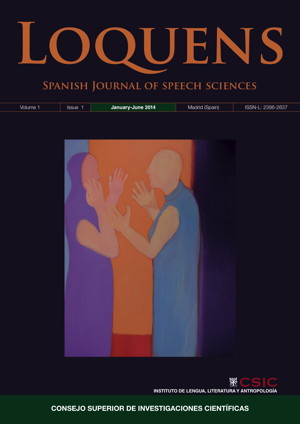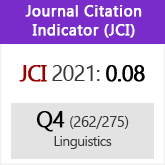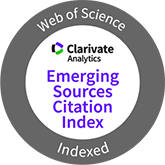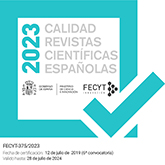What is computational phonology?
DOI:
https://doi.org/10.3989/loquens.2014.004Keywords:
computational phonologyAbstract
Computational phonology is not one thing. Rather, it is an umbrella term which may refer to work on formal language theory, computer-implemented models of cognitive processes, and corpus methods derived from the literature on natural language processing (NLP). This article gives an overview of these distinct areas, identifying commonalities and differences in the goals of each area, as well as highlighting recent results of interest. The overview is necessarily brief and subjective. Broadly speaking, it is argued that learning is a pervasive theme in these areas, but the core questions and concerns vary too much to define a coherent field. Computational phonologists are more united by a shared body of formal knowledge than they are by a shared sense of what the important questions are.
Downloads
References
Adriaans, F., & Kager, R. (2010). Adding generalization to statistical learning: The induction of phonotactics from continuous speech. Journal of Memory and Language, 62, 311-331. http://dx.doi.org/10.1016/j.jml.2009.11.007
Albright, A., & Hayes, B. (2003). Rules vs. analogy in English past tenses: A computational/experimental Study. Cognition, 90, 119-161. http://dx.doi.org/10.1016/S0010-0277(03)00146-X
Aslin, R. N., Woodward, J., LaMendola, N., & Bever, T. G. (1996). Models of word segmentation in fluent maternal speech to infants. In J. L. Morgan & K. Demuth (Eds.), Signal to syntax: Bootstrapping from speech to grammar in early acquisition (pp. 117-134). Mahwah, NJ: Erlbaum.
Baayen, R. H. (2001). Word frequency distributions. Dordrecht, Netherlands: Kluwer Academic. http://dx.doi.org/10.1007/978- 94-010-0844-0
Baković, E. (2007). A revised typology of opaque generalisations. Phonology,24, 217-259. http://dx.doi.org/10.1017/S095267 5707001194
Baković, E. (2011). Opacity and ordering. In J. Goldsmith, J. Riggle & A. C. L. Yu (Eds.), The handbook of phonological theory (2nd ed.). Oxford, UK: Wiley-Blackwell. http://dx.doi.org/10.1002/ 9781444343069.ch2
Batchelder, E. O. (2002). Bootstrapping the lexicon: A computational model of infant speech segmentation. Cognition, 83, 167-206. http://dx.doi.org/10.1016/S0010-0277(02)00002-1
Baum, L. E., & Petrie, T. (1966). Statistical inference for probabilistic functions of finite state Markov chains. The Annals of Mathematical Statistics, 37(6), 1554-1563. http://dx.doi.org/10.1214/aoms/1177699147
Berger, A., Della Pietra, S., & Della Pietra, V. (1996). A maximum entropy approach to natural language processing. Computational Linguistics, 22(1), 39-71.
Blanchard, D., Heinz, J., & Golinkoff, R. (2010). Modeling the contribution of phonotactic cues to the problem of word segmentation. Journal of Child Language, 37, 487-511. http://dx.doi.org/10.1017/S030500090999050X PMid:20307346
Boersma, P. (2003). [Review of the book Learnability in Optimality Theory, by B. Tesar & P. Smolensky]. Phonology, 20, 436-446. http://dx.doi.org/10.1017/S0952675704230111
Boersma, P., & Hayes, B. (2001). Empirical tests of the Gradual Learning Algorithm. Linguistic Inquiry, 32, 45-86. http://dx.doi.org/10.1162/002438901554586
Bortfeld, H., Morgan, J. L., Golinkoff, R. M., & Rathbun, K. (2005). Mommy and me: Familiar names help launch babies into speech stream segmentation. Psychological Science, 16, 298-304. http://dx.doi.org/10.1111/j.0956-7976.2005.01531.x
Brent, M. R., & Cartwright, T. A. (1996). Distributional regularity and phonotactic constraints are useful for segmentation. Cognition, 61, 93-125. http://dx.doi.org/10.1016/S0010- 0277(96)00719-6
Brown, P., & Mercer, R. (2013). Twenty years of Bitext [Transcription and slides]. Invited talk. EMNLP workshop Twenty years of Bitext. Seattle, WA. Retrieved from: http://cs.jhu.edu/~post/bitext/
Brown, R. (1973). A first language: The early stages. Cambridge, MA: Harvard University Press. http://dx.doi.org/10.4159/harvard.9780674732469
Buccola, B., & Sonderegger, M. (2013). On the expressivity of Optimality Theory versus rules: An application to opaque patterns. Refereed presentation presented at the meeting Phonology 2013, Umass Amherst, 09 November 2013.
Cairns, P., Shillcock, R. C., Chater, N., & Levy, J. (1997). Bootstrapping word boundaries: A bottom-up corpus-based approach to speech segmentation. Cognitive Psychology, 33, 111-153. http://dx.doi.org/10.1006/cogp.1997.0649
Chomsky, N. (1956). Three models for the description of language. IRE Transactions on Information Theory, 2, 113-124. http://dx.doi.org/10.1109/TIT.1956.1056813
Chomsky, N. (1959). [Review of the book Verbal Behavior, by B. F. Skinner]. Language, 35(1), 26-58. http://dx.doi.org/10.2307/ 411334
Chomsky, N. & Halle, M. (1968). The sound pattern of English. New York: Harper & Row.
Christiansen, M. H., Allen, J., & Seidenberg, M. S. (1998). Learning to segment speech using multiple cues: A connectionist model. Language and Cognitive Processes, 13(2-3), 221-268. http://dx.doi.org/10.1080/016909698386528
Coetzee, A. W., & Pater, J. (2011). The place of variation in phonological theory. In J. Goldsmith, J. Riggle & A. C. L. Yu (Eds.), The handbook of phonological theory (2nd ed.). Oxford, UK: Wiley-Blackwell. http://dx.doi.org/10.1002/9781444 69.ch13
Coleman, J., & Pierrehumbert, J. (1997). Stochastic phonological grammars and acceptability. In 3rd Meeting of the ACL Special Interest Group in Computational Phonology: Proceedings of the Workshop, 12 July 1997 (pp. 49-56). Somerset NJ: Association for Computational Linguistics. PMid:9037913
Daland, R. (2009). Word segmentation, word recognition, and word learning: A computational model of first language acquisition (unpublished doctoral dissertation). Northwestern University, IL. Retrieved from: http://www.linguistics.northwestern.edu/docs/dissertations/dalandDissertation.pdf
Daland, R. (2013). Variation in child-directed speech: A case study of manner class frequencies. Journal of Child Language, 40(5), 1091-1122. http://dx.doi.org/10.1017/S0305000912000372
Daland, R., & Pierrehumbert, J.B. (2011). Learning diphone-based segmentation. Cognitive Science, 35(1), 119-155. http://dx.doi.org/10.1111/j.1551-6709.2010.01160.x PMid:21428994 Daland, R., & Zuraw, K. (2013). Does Korean defeat phonotactic word segmentation? Short paper presented at the 51st Annual Meeting of the Association for Computational Linguistics in Sofia, Bulgaria, August 4-9, 2013.
Dale, P. S., & Fenson, L. (1996). Lexical development norms for young children. Behavior Research Methods, Instruments, & Computers, 28, 125-127. http://dx.doi.org/10.3758/BF03203646
Daugherty, K., & Seidenberg, M. S. (1992). Rules or connections? The past tense revisited. In Proceedings of the Fourteenth Annual Conference of the Cognitive Science Society (pp. 259-264). Hillsadle, NJ: Erlbaum.
Eisner, J. (2002). Parameter estimation for probabilistic finite-state transducers. In Proceedings of the 40th Annual Meeting of the Association for Computational Linguistics (pp. 1-8). East Stroudsburg, PA: Association for Computational Linguistics. http://dx.doi.org/10.3115/1073083.1073085
Ellison, M. T. (1994). Phonological derivation in optimality theory. In Proceedings of the 15th International Conference on Computational Linguistics (COLING) (Vol. 2, pp. 1007-1013). Kyoto, Japan: Association for Computational Linguistics. http://dx.doi.org/10.3115/991250.991312
Elman, J. L. (1990). Finding structure in time. Cognitive Science, 14, 179-211. http://dx.doi.org/10.1207/s15516709cog1402_1
Elman, J. L., & McClelland, J. L. (1985). An architecture for parallel processing in speech recognition: The TRACE model. In M. R. Schroeder (Ed.), Speech recognition (pp. 6-35). Gottingen, Germany: Biblioteca Phonetica.
Fleck, M. M. (2008). Lexicalized phonotactic word segmentation. In Proceedings of the 46th Annual Meeting of the Association for Computational Linguistics: Human Language Technologies (pp. 130-138). Madison, WI: Omnipress.
Fourtassi, A., Börschinger, B., Johnson, M., & Dupoux, E. (2013). Whyisenglishsoeasytosegment. In Proceedings of the 4th Workshop on Cognitive Modeling and Computational Linguistics (pp. 1-10). Sofia, Bulgaria, August 8, 2013.
Frank, R., & Satta, G. (1998). Optimality theory and the computational complexity of constraint violability. Computational Linguistics, 24, 307-315.
Gold, E. M. (1967). Language identification in the limit. Information and Control, 10(5), 447-474. http://dx.doi.org/10.1016/S0019- 9958(67)91165-5
Goldsmith, J. (1976). Autosegmental phonology. Doctoral dissertation, MIT, MA.
Goldsmith, J. A. (1990). Autosegmental and metrical phonology. Oxford, UK: Basil Blackwell.
Goldwater, S. (2006). Nonparametric Bayesian models of lexical acquisition (unpublished doctoral dissertation). Brown University, RI. Retrieved from: http://homepages.inf.ed.ac.uk/sgwater/papers/thesis_1spc.pdf
Goldwater, S., & Johnson, M. (2003). Learning OT constraint rankings using a maximum entropy model. In Proceedings of the Workshop on Variation within Optimality Theory (pp. 113-122). Stockholm University, Sweden.
Goldwater, S., Griffiths, T. L., & Johnson, M. (2009). A Bayesian framework for word segmentation: Exploring the effects of context. Cognition,112(1), 21-54. http://dx.doi.org/10.1016/j.cognition.2009.03.008 PMid:19409539
Graf, T. (2010a). Comparing incomparable frameworks: A model theoretic approach to phonology. University of Pennsylvania Working Papers in Linguistics, 16(1), art. 10. Retrieved from: http://repository.upenn.edu/pwpl/vol16/iss1/10 Graf, T. (2010b). Formal parameters of phonology: From Government Phonology to SPE. In T. Icard & R. Muskens (Eds.), Interfaces: Explorations in logic, language and computation, Lecture Notes in Artificial Intelligence 6211 (pp. 72-86). Berlin, Germany: Springer.
Hayes, B. (2004). Phonological acquisition in Optimality Theory: the early stages. In R. Kager, J. Pater & W. Zonneveld (Eds.), Fixing priorities: Constraints in phonological acquisition (pp. 158-203). Cambridge University Press. PMid:14747424
Hayes, B. (2011). Interpreting sonority-projection experiments: The role of phonotactic modeling. In Proceedings of the 17th International Congress of Phonetic Sciences (ICPhS 11-Hong Kong) (pp. 835-838) Hong Kong, PRC.
Hayes, B., Kie, Z., Siptár, P., & Londe, Z. C. (2009). Natural and unnatural constraints in Hungarian vowel harmony. Language, 85(4), 822-863. http://dx.doi.org/10.1353/lan.0.0169
Hayes, B., & White, J. (2013). Phonological naturalness and phonotactic learning. Linguistic Inquiry, 44(1), 45-75. http://dx.doi.org/10.1162/LING_a_00119
Hayes, B., & Wilson, C. (2008). A maximum entropy model of phonotactics and phonotactic learning. Linguistic Inquiry, 39(3), 379-440. http://dx.doi.org/10.1162/ling.2008.39.3.379
Heinz, J. (2007). The Inductive Learning of Phonotactic Patterns (doctoral dissertation), University of California, Los Angeles.
Heinz, J. (2010). String extension learning. In Proceedings of the 48th Annual Meeting of the Association for Computational Linguistics in Uppsala, Sweden (pp. 897-906).
Heinz, J. (2011a). Computational Phonology - Part I: Foundations. Language and Linguistics Compass, 5(4), 140-152. http://dx.doi.org/10.1111/j.1749-818X.2011.00269.x
Heinz, J. (2011b). Computational Phonology - Part II: Grammars, Learning, and the Future. Language and Linguistics Compass, 5(4), 153-168. http://dx.doi.org/10.1111/j.1749-818X.2011. 00268.x
Heinz, J., & Koirala, C. (2010). Maximum likelihood estimation of feature-based distributions. In Proceedings of the 11th Meeting of the ACL Special Interest Group on Computational Morphology and Phonology, 28-37, Uppsala, Sweden.
Heinz, J., & Lai, R. (2013). Vowel harmony and subsequentiality. In A. Kornai & M. Kuhlmann (Eds.), Proceedings of the 13th Meeting on Mathematics of Language, Sofia, Bulgaria.
Hirschberg, J. (1998). 'Every time I fire a linguist, my performance goes up', and other myths of the statistical natural language processing revolution. Invited talk. 15th National Conference on Artificial Intelligence, Madison, WI.
Jardine, A. (in press). Logic and the Generative Power of Autosegmental Phonology. In Supplemental Proceedings of Phonology 2013. Retrieved from: https://sites.google.com/site/adamajardine/research-interests
Jarosz, G. (2006). Rich lexicons and restrictive grammars - Maximum likelihood learning inOptimality Theory (doctoral dissertation). Johns Hopkins University. Retrieved from Rutgers Optimality Archive No. 884.
Jarosz, G. (2013). Learning with hidden structure in Optimality Theory and Harmonic Grammar: Beyond Robust Interpretive Parsing. Phonology, 30, 27-71. http://dx.doi.org/10.1017/S0952675713000031
Jelinek, F., Bahl, L., & Mercer, R. (1975). Design of a linguistic statistical decoder for the recognition of continuous speech. IEEE Transactions of Information Theory, 21(3), 250-256. http://dx.doi.org/10.1109/TIT.1975.1055384
Jusczyk, P. W., Hohne, E. A., & Bauman, A. (1999). Infants' sensitivity to allophonic cues for word segmentation. Perception and Psychophysics, 61, 1465-1476. http://dx.doi.org/10.3758/BF03213111 PMid:10598463
Jusczyk, P. W., Houston, D. M., & Newsome, M. (1999). The beginnings of word segmentation in English-learning infants. Cognitive Psychology,39(3-4), 159-207. http://dx.doi.org/10.1006/cogp.1999.0716 PMid:10631011
Kaplan, R.M., & Kay, M. (1994). Regular models of phonological rule systems. Computational Linguistics, 20(3), 331-379.
Karttunen, L. (1998). The proper treatment of optimality theory in computational phonology. In Proceedings of the International Workshop on Finite State Methods in Natural Language Processing (1-12). Ankara, Turkey: Association for Computational Linguistics.
Kearns, M., & Valiant, L. (1994). Cryptographic limitations on learning boolean formulae and finite automata. Journal of the ACM,41(1), 67-95. http://dx.doi.org/10.1145/174644.174647
Larsen, D., & Heinz, J. (2012). Neutral vowels in sound-symbolic vowel harmony in Korean. Phonology, 29, 433-464. http://dx.doi.org/10.1017/S095267571200022X
Legendre, G., Miyata, Y., & Smolensky, P. (1990). Harmonic Grammar: A formal multi-level connectionist theory of linguistic well-formedness: An application. In Proceedings of the twelfth annual conference of the Cognitive Science Society (pp. 884-891). Cambridge, MA: Lawrence Erlbaum.
Li, M., & Vitányi, P. M. B. (1991). Learning simple concepts under simple distributions. SIAM Journal of Computing, 20, 911-935. http://dx.doi.org/10.1137/0220056
Lignos, C. (2012). Infant word segmentation: An incremental, integrated model. In Proceedings of the West Coast Conference on Formal Linguistics, 30, April 13-15, 2012.
MacWhinney, B. (2000). The CHILDES Project: Tools for Analyzing Talk. Volume I: Transcription format and programs. Volume II: The database. Mahwah, NJ: Lawrence Erlbaum.
Magri, G. (2012). Constraint promotion: not only convergent but also efficient. In CLS 48: Proceedings of the 48th annual conference of the Chicago Linguistic Society, Chicago, IL.
Magri, G. (in press). Error-driven and batch models of the acquisition of phonotactics: David defeats Goliath. In Phonology 2013: Proceedings of the 2013 Phonology Conference, November 8-10, 2013, Amherst, MA.
Mandel, D. R., Jusczyk, P. W., & Pisoni, D. B. (1995). Infants' recognition of the sound patterns of their own names. Psychological Science, 6, 315-318. http://dx.doi.org/10.1111/j.1467-9280.1995.tb00517.x
Marcus, G. F. (1995). The acquisition of the English past tense in children and multi-layered conectionist networks. Cognition, 56, 271-279. http://dx.doi.org/10.1016/0010-0277(94)00656-6 Marcus, G. F., Brinkmann, U., Clahsen, H., Wiese, R., & Pinker, S. (1996). German inflection: The exception that proves the rule. Cognitive Psychology, 29, 189-256. http://dx.doi.org/10.1016/0010-0277(94)00656-6
Mattys, S. L., & Jusczyk, P. W. (2001). Phonotactic cues for segmentation of fluent speech by infants. Cognition, 78, 91-121. http://dx.doi.org/10.1016/S0010-0277(00)00109-8 McCarthy, J.J. (1981). A prosodic theory of non-concatenative morphology. Linguistic Inquiry, 12(3), 373-418.
McCarthy, J.J. (2008). The gradual path to cluster simplification. Phonology, 25, 271-319. http://dx.doi.org/10.1017/S095267 5708001486
McCarthy, J.J. (2011). Autosegmental spreading in Optimality Theory. In J. Goldsmith, A. E. Hume & L. Wetzels (Eds.), Tones and Features (pp. 195-222). Berlin, Germany: Mouton de Gruyter. http://dx.doi.org/10.1515/9783110246223.195
McCarthy, J.J., & Prince, A. (1994). The emergence of the unmarked: Optimality in prosodic morphology. In Proceedings of the North East Linguistics Society 24. Amherst, MA.
Pearl, L., Goldwater, S., & Steyvers, M. (2011). Online Learning Mechanisms for Bayesian Models of Word Segmentation. Research on Language and Computation, 8(2-3), 107-132. http://dx.doi.org/10.1007/s11168-011-9074-5
Phillips, L. & Pearl, L. (2012). Syllable-based Bayesian inference: A (more) plausible model of word segmentation. Workshop on Psychocomputational Models of Human Language Acquisition. Portland, OR.
Pierrehumbert, J. (1994). Syllable structure and word structure: a study of triconsonantal clusters in English. In P. Keating (Ed.), Papers in laboratory phonology III: Phonological structure and phonetic form (pp. 168-188). Cambridge, UK: Cambridge University Press. http://dx.doi.org/10.1017/CBO9780511659461.011
Pinker, S., & Prince, A. (1988). On language and connectionism: Analysis of a Parallel Distributed Processing model of language acquisition. Cognition, 28(1-2), 73-193. http://dx.doi.org/10.1016/0010-0277(88)90032-7
Plunkett, K. & Marchman, V. (1991). U-shaped learning and frequency effects in a multi-layered perceptron: Implications for child language acquisition. Cognition, 38, 43-102. http://dx.doi.org/10.1016/0010-0277(91)90022-V
Potts, C., Pater, J., Jesney, K., Bhatt, R., & Becker, M. (2010). Harmonic Grammar with linear programming: From linear systems to linguistic typology. Phonology, 27, 77-117. http://dx.doi.org/10.1017/S0952675710000047 Potts, C., & Pullum, G. K. (2002). Model theory and the content of OT constraints. Phonology, 19, 361-393. http://dx.doi.org/10.1017/S0952675710000047
Prince, A., & Smolensky, P. (1993). Optimality Theory: Constraint interaction in generative grammar. Technical Report, RUCSS, Rutgers University, New Brunswick, NJ. Published in 2004 by Blackwell.
Prince, A., & Smolensky, P. (2002). Optimality Theory: Constraint interaction in generative grammar. Retrieved from: roa.rutgers.edu/files/537-0802/537-0802-PRINCE-0-0.PDF
Prince, A., & Smolensky, P. (2004). Optimality Theory: Constraint interaction in generative grammar. Oxford: Blackwell. http://dx.doi.org/10.1002/9780470759400
Riggle, J. (2004). Generation, recognition, and learning in finite state Optimality Theory (doctoral dissertation). UCLA, CA.
Riggle, J. (2009). Violation semirings in Optimality Theory. Research on Language and Computation, 7(1), 1-12. http://dx.doi.org/10.1007/s11168-009-9063-0
Riggle, J., & Wilson, C. (2005). Local optionality. In Proceedings of NELS 35. Amherst, MA: GLSA.
Rumelhart, D. E., & McClelland, J. L. (1986). On learning the past tenses of English verbs: Implicit rules or parallel distributed processing? In J. L. McClelland, D. E. Rumelhart, & the PDP Research Group (Eds.), Parallel distributed processing: Explorations in the microstructure of cognition (Vol. 2, pp. 216-271). Cambridge, MA: MIT Press.
Saffran, J. R., Aslin, R. N., & Newport, E. L. (1996). Statistical learning by 8-month-old infants. Science, 274, 1926-1928. http://dx.doi.org/10.1126/science.274.5294.1926
Shieber, S. M. (1985). Evidence against the context-freeness of natural language. Linguistics and Philosophy, 8(3), 333-343, http://dx.doi.org/10.1007/BF00630917
Smolensky, P., & Legendre, G. (2006). The Harmonic Mind: From neural computation to Optimality-Theoretic grammar (Vol. 1: Cognitive Arquitecture, pp. xvii-563. Vol. 2: Linguistic and Philosophical Implications, pp. xvii-611). Cambridge, MA: MIT Press.
Stabler, E. (2009). Computational models of language universals. In M. H. Christiansen, C. Collins, & S. Edelman (Eds.), Language Universals (Rev. ed., pp. 200-223). Oxford, UK: Oxford University Press. http://dx.doi.org/10.1093/acprof:oso/ 9780195305432.003.0010
Strauss, T. J., Harris, H. D., & Magnuson, J. S. (2007). jTRACE : A reimplementation and extension of the TRACE model of speech perception and spoken word recognition. Behavior Research Methods, 39(1), 19-30. http://dx.doi.org/10.3758/BF03192840
Tesar, B., & Smolensky, P. (2000) Learnability in Optimality Theory. Cambridge, MA: MIT Press.
Twain, M. (2006). Chapters from My Autobiography -- XX. North American Review DCXVIII. Project Gutenberg. Retrieved from: http://www.gutenberg.org/files/19987/19987-h/19987-h.htm (original work published in 1906).
Valiant, L. G. (1984). A theory of the learnable. Communications of the ACM 27, 1134-1142. http://dx.doi.org/10.1145/1968.1972
Viterbi, A. J. (1967). Error bounds for convolutional codes and an asymptotically optimum decoding algorithm. IEEE Transactions on Information Theory 13(2), 260-269. http://dx.doi.org/10.1109/TIT.1967.1054010
Xanthos, A. (2004). Combining utterance-boundary and predictability approaches to speech segmentation. In W. G. Sakas (Ed.), Proceedings of the first workshop on psycho-computational models of language acquisition at COLING 2004 (pp. 93-100). Geneva, Switzerland.
Zipf, G. K. (1935). The Psychobiology of Language. Boston, MA: Houghton-Mifflin.
Zipf, G. K. (1949). Human Behavior and the Principle of Least Effort. Cambridge, MA: Addison-Wesley Press. PMid:15405394
Zuraw, K. (2006). Using the web as a phonological corpus: a case study from Tagalog. In EACL-2006: Proceedings of the 11th Conference of the European Chapter of the Association for Computational Linguistics/Proceedings of the 2nd International Workshop on Web As Corpus (pp. 59-66). http://dx.doi.org/ 10.3115/1628297.1628306
Published
How to Cite
Issue
Section
License
Copyright (c) 2014 Consejo Superior de Investigaciones Científicas (CSIC)

This work is licensed under a Creative Commons Attribution 4.0 International License.
© CSIC. Manuscripts published in both the printed and online versions of this Journal are the property of Consejo Superior de Investigaciones Científicas, and quoting this source is a requirement for any partial or full reproduction.All contents of this electronic edition, except where otherwise noted, are distributed under a “Creative Commons Attribution 4.0 International” (CC BY 4.0) License. You may read here the basic information and the legal text of the license. The indication of the CC BY 4.0 License must be expressly stated in this way when necessary.
Self-archiving in repositories, personal webpages or similar, of any version other than the published by the Editor, is not allowed.
















